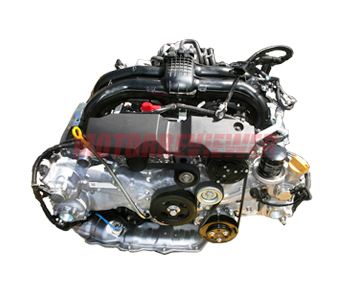Subaru FB25 2.5L Engine Specs, Problems, Reliability, Info

Subaru FB25/FB25B Overview
The FB-series are completely new engines produced by Subaru. The 2.5-liter FB25 engine is a non-turbo gasoline four-cylinder boxer engine that has replaced the EJ25 in the Legacy and Forester models. The production of the new 2.5-liter engine began in 2010. This engine is packed with innovative and modern features, such as the small capacity version — the FB20 engine. Let's take a closer look at its design and tell about its pros and cons.
FB25 FB25B Engine Design
The FB25 (or FB25B) is based on the FB20 aluminum cylinder block with cast iron sleeves. To achieve a larger displacement, there is a 94-mm bore, but the stroke remains the same. The thickness of the cylinder walls is only 3.5 millimeters. Of course, the FB25 engine received new pistons, which brought down the compression ratio to 10:1.
On both sides of the block, there are 8-valve (4 valves per cylinder) aluminum DOHC heads with roller rocker arms. The FB heads consist of two parts — the cylinder head and the camshaft carrier. This allows for a reduction in metal thickness and weight. FB25 engines are equipped with maintenance-free timing chains. Both camshafts have a variable valve timing system installed (Subaru's dual AVCS). The fuel injectors have been moved to the cylinder heads, making the injection system more complex but also more efficient. The exhaust system has some upgrades as well. There is a new exhaust manifolds with an optimized tube diameter, which helps to improve the catalytic converter's warm-up time and gives the engine more power.
The FB25 engine has better performance at lower engine speeds compared to the EJ25. While it has the same horsepower, it has increased torque at lower RPM. This makes the FB25 more efficient in terms of fuel consumption. These features make Subaru's new 2.5-liter engine a more suitable choice for those looking to save money on driving.
Updates
In 2014, some changes were made to the engine. The manufacturer reduced the thickness of the cylinder walls to 3.2 mm and installed new pistons, which increased the compression ratio to 10.3. The cylinder heads have also been revised. The intake channels inside the heads have been redesigned, and they were equipped with 36-mm intake valves. The upgraded engine also has a new intake manifolds and a lightweight exhaust system.
In 2018, Subaru introduced a new version of this engine called FB25D. The main difference between FB25D and others FB25 engines is the direct fuel injection system.
Engine Specs
10.3:1 - from 2014
API SM/SN (ILSAC GF-4 or GF-5)
Oil recommendations and capacity may vary depending on the car model, year, and market. Please check the service manual specific to your vehicle!
Subaru 2.5 FB25/FB25B Engine Problems and Reliability
All engines have flaws, and FB25 is not an exception. Here are some of the typical problems:
- The FB25 does not have a major issue with high oil consumption, unlike the FB20. However, some owners still complain about increased engine oil consumption from time to time. More often, oil consumption appears due to the stuck piston rings.
- This engine requires high-quality engine oil only. Otherwise, problems with the camshafts and phase adjusters will not be long in coming.
- There are no hydraulic lash adjusters. Valve clearances should be checked and adjusted every 60,000 miles (100,000 km).
- The manufacturer also announced a service bulletin to eliminate leaks from the camshaft bed for vehicles produced between 2012 and 2019.
Summary
In general, the FB25 engine is quite reliable and durable, with an approximate engine lifespan of 200,000 miles (300,000 km). But in order for this engine to last so long, you need to follow some basic rules: precisely follow the maintenance schedule, change the engine oil even more often, use only high-quality and recommended engine oils and other fluids, and fix minor breakdowns immediately.
